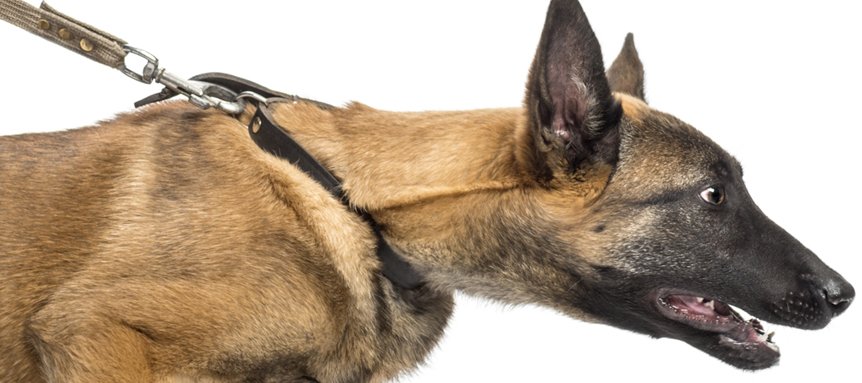Did you ever stop to think about what happens under your dog’s collar when it pulls on the lead? Persistent lead pulling will damage your dog’s neck. We’ve distilled a thought provoking article from dog behaviourist Els Vidts (www.freedogz.com) for our latest blog.
The dog’s anatomy is basically the same as ours, and it’s neck is also just as sensitive as ours. If your dog’s lead is attached to a collar, persistent lead pulling will result in the collar applying concentrated pressure to a very small area. This will eventually lead to damage to the vital organs of the neck that are not protected against this level of pressure, causing PAIN.
Skin
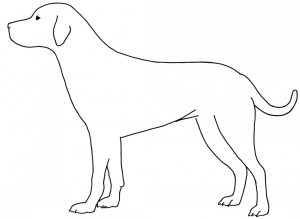
The skin is a vital organ, forming an important barrier between the external environment and the internal body. Collar damage can lead to hair loss, irritation, bruises, wounds and pain.
Muscles
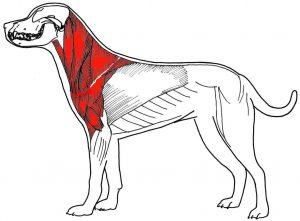
The dog’s neck muscles are constantly working against gravity to keep it’s head up. During movement the muscles of the neck keep the head balanced. Injury to the neck muscles influences the whole body movement and can lead to contusions, strains and pain.
Arteries and veins
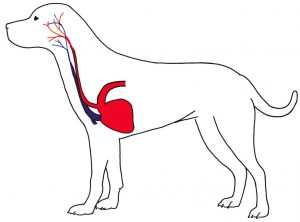
The blood vessels in the neck carry blood to and from the head and brain. Pressure on the veins causes higher blood pressure in the brain and intra-ocular pressure, long-term effects may be impaired blood circulation in the brain and glaucoma.
Spinal cord and nerves
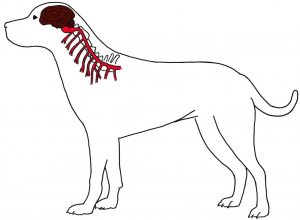
Tension on the collar results in abnormal shearing stresses between vertebrae, that may result in narrowing of the spinal canal and impingement of the spinal cord.
Nerves branch out from the spinal cord and exit the spinal canal between two vertebrae. These nerves conduct impulses from the brain to the muscles and from the skin to the brain. Osteo-arthritis and herniated discs can impinge the nerves causing pain and impaired neurological functions.
Vertebrae and intervertebral discs and tongue bone
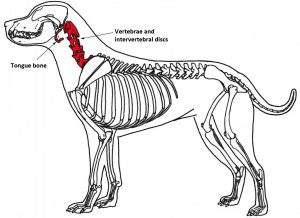
Seven vertebrae form the cervical pine of the dog. Intervertebral discs consist of cartilage and collagen fibres. Lead pulling causing tension on the collar results in a shear force causing unnatural movement that accelerates degeneration, causing osteo-arthritis of the spine and possibly herniation of the discs.
The tongue bone is a small horseshoe-shaped bone where muscles of the tongue and lower mouth attach. It is important in movements of the tongue and swallowing. Tension on the collar can lead to difficult and painful swallowing.
Trachea, larynx and oesophagus
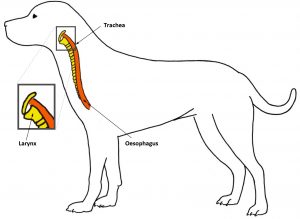
The trachea, or windpipe, is a tube reinforced by c-shaped cartilage rings. The cartilage rings can flatten or break, resulting in narrower diameter and thus respiratory problems.
The larynx sits at the top of the windpipe and holds a valve that closes to keep food from sliding down to the lungs. Collar damage can lead to difficulties swallowing, choking, and pain.
The oesophagus, or gullet, is a muscular tube which transports food from the mouth to the stomach. Collar damage can lead to difficulties swallowing and pain.
Source:
FreeDogz, 2014. Harness vs Collar [online]. Available at: http://www.freedogz.be/equipment/index.php?route=information/information&information_id=20.
